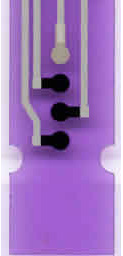Sep 16 2010
Earlier this year, the North Review of Drink and Drug Driving Law highlighted the value of a spit test to catch drug drivers. Testing for drugs in saliva is very challenging, but findings announced today by Universal Sensors Ltd (Cambridge, UK) show that its Vantix biosensor technology can detect trace quantities of both cocaine and cannabis in saliva within minutes.
In 2008, drug use was identified as a contributing factor in 3% of deaths on British roads. But the number of accidents that are attributed to drug driving is likely to be a gross underestimate, partly because of the difficulty in detecting drug use. A test based on a non-invasive sample such as saliva would reduce the time and resources required to identify drug drivers.

Dr. Peter Swarbrick, who together with Dr. Olga Leonardova led the research for the new test at Universal Sensors, says: "A major hurdle in the development of a test is that saliva is a very difficult sample to analyse. It contains proteins, fats, sugars and mucus (as well as interfering residues from tobacco, coffee, tea and prescribed medicines), all of which can reduce the sensitivity and specificity of a test."
"We were really pleased with the sensitivity achieved by our technology, which can detect as little a 1 ng/ml of Benzoylecgonine (a metabolite of cocaine) and 5 ng/ml of tetrahydrocannabinol (the main psychoactive substance in cannabis). Both of these were achieved without having to clean or pre-treat the saliva sample. This is well within the target sensitivities recommended in the recent report by DRUID, an EU-funded consortium studying 'Driving under the Influence of Drugs, Alcohol and Medicines'."
The misuse of drugs can cause inattention, poor coordination, slowed reaction time, and an inability to keep in lanes. Sir Peter North CBE QC recently published his Review of the Drink and Drug Driving Law, which highlighted the gravity of the problem, and made a number of recommendations. This included the development of a 'drugalyser' device, which would allow police officers to quickly screen drivers suspected of being impaired through the use of drugs, without the need to take a blood sample.
The current procedure is that when police pull over a driver they suspect to be unfit to drive they perform a Field Impairment Test (FIT), which looks at pupil dilation, balance and coordination. This is an extremely useful tool to identify drivers who are unfit to drive, but in order to confirm any impairment is related to drug use, a blood test must be performed.
The blood tests are laboratory based and require a medical professional trained in forensics to take a sample. The ease of breathalysing relative to the difficulty of taking a blood sample is a major factor in causing drug driving offences to go undetected. Drugs and alcohol are often consumed simultaneously, but once the police have detected alcohol they are unlikely to go to the effort of drug testing. A test which can be performed on untreated saliva by a member of the police force would save police time and resources, and increase the proportion of drug driver convictions, making the roads safer for all.
The DRUID consortium reported that none of the commercially available tests for multiple drugs in one saliva sample showed sufficient sensitivity, specificity and accuracy for all of the separate components. Universal Sensors have demonstrated the effectiveness of their technology in tests for the priority targets cocaine and cannabis, and they are confident that it will be equally robust in tests for other drugs.
Dr Swarbrick continues, "Using our multi-sensor Vantix chips, we are now in a position to develop a multi-drug detector which is fast and easy enough to be used by non-medical staff without specialist training. It will provide a simple confirmation of the presence or absence of the drug. Blood tests then only need to be performed on individuals whose saliva test is positive."
The Vantix biosensor has the potential to provide police with a straightforward, unambiguous test result, which would help identify drug drivers and secure convictions. Such a sensitive technology would make a zero tolerance approach to drug drivers possible for the first time.